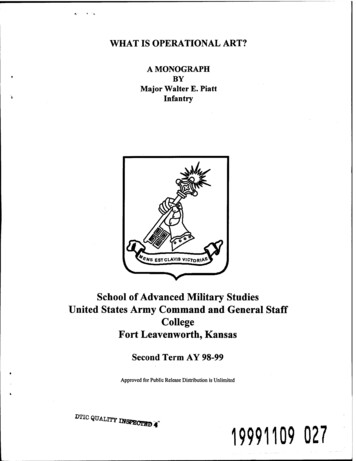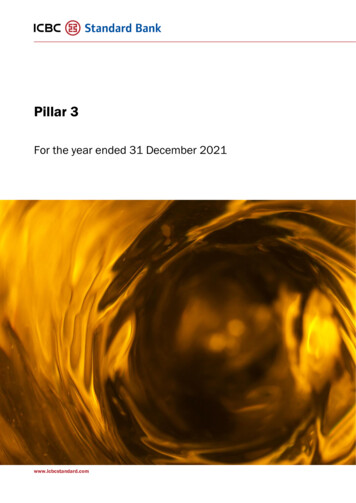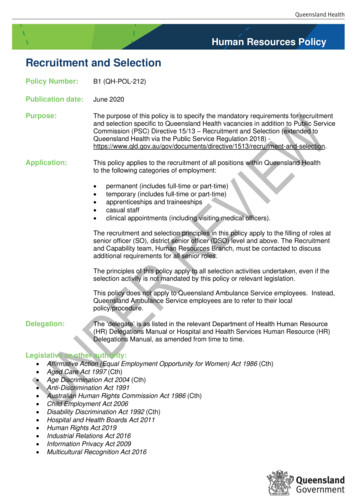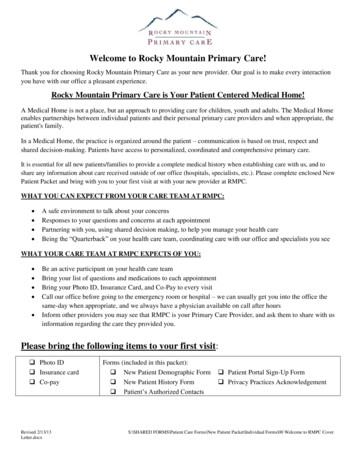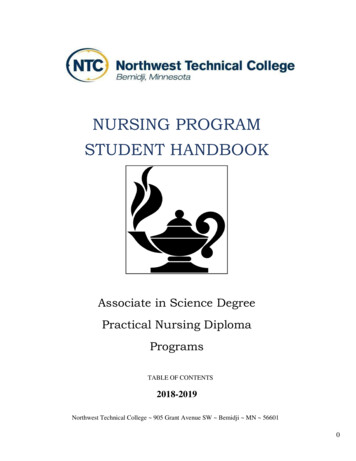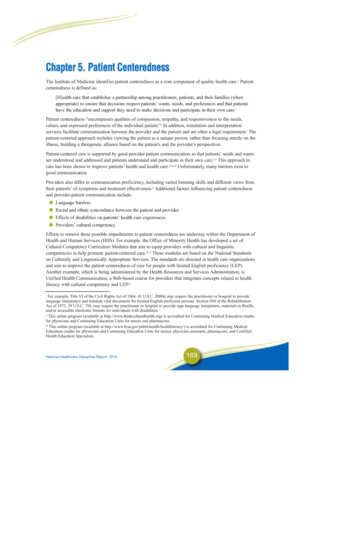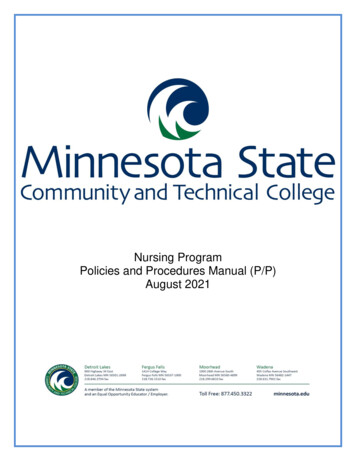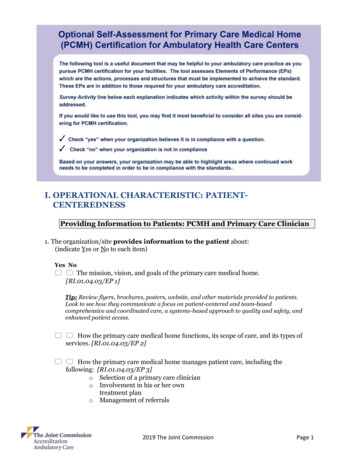
Transcription
I. OPERATIONAL CHARACTERISTIC: PATIENTCENTEREDNESSProviding Information to Patients: PCMH and Primary Care Clinician1. The organization/site provides information to the patient about:(indicate Yes or No to each item)Yes No The mission, vision, and goals of the primary care medical home.[RI.01.04.03/EP 1]Tip: Review flyers, brochures, posters, website, and other materials provided to patients.Look to see how they communicate a focus on patient-centered and team-basedcomprehensive and coordinated care, a systems-based approach to quality and safety, andenhanced patient access. How the primary care medical home functions, its scope of care, and its types ofservices. [RI.01.04.03/EP 2] How the primary care medical home manages patient care, including thefollowing: [RI.01.04.03/EP 3]o Selection of a primary care cliniciano Involvement in his or her owntreatment plano Management of referralsPage 12019 The Joint CommissionPage 1
oooCoordination of careCollaboration with patient-selected clinicians who provide specialty care orsecond opinionsCommunication with the primary care medical home about health careconcerns/other information Patient responsibilities, including providing health history and currentmedications and participating in self-management activities. [RI.01.04.03/EP 5] The patient’s right to obtain care from other clinicians within the primary caremedical home, to seek a second opinion, and to seek specialty care.[RI.01.04.03/EP 6] The credentials and educational background information of individuals serving inthe role of primary care clinician. [RI.01.04.03/EP 7]YES at all sites YES at some sites: (list sites)NO[Explain any items above that are marked No]Site Name(s) and Comments:Survey Activity: Patient Tracer, Opening Conference/Org orientation, Governing Board Session (for BPHCsupported Health centers only)Patient-designated Primary Care Clinician1.Each patient has a designated primary care clinician. [PC.02.01.01/EP 16]YES at all sitesYES at some sites: (list sites)NOSite Name(s) and Comments:Survey Activity: Patient Tracer, Opening Conference/Org orientation2. The organization allows the patient to select his or her primary care clinician.[RI.01.04.01/EP 7]YES at all sitesYES at some sites: (list sites)NOSite Name(s) and Comments:Survey Activity: Patient Tracer, Opening Conference/Org orientationPage 22019 The Joint CommissionPage 2
Patient Involvement in His or Her Care Decisions1. The organization respects the patient’s right to make decisions about themanagement of his or her care. [RI.01.02.01/EP 31]YES at all sitesYES at some sites: (list sites)NOSite Name(s) and Comments:Survey Activity: Patient Tracer, Opening Conference/Org orientation2. The interdisciplinary team involves the patient in the development of his or hertreatment plan. [PC.02.04.05/EP 11]YES at all sitesYES at some sites: (list sites)NOSite Name(s) and Comments:Survey Activity: Patient Tracer, Opening Conference/Org orientation, Clinical/staff Leadership Session (for BPHCsupported centers only)3. The interdisciplinary team works in partnership with the patient to achieve plannedoutcomes. [PC.02.04.05/EP 9]YES at all sitesYES at some sites: (list sites)NOSite Name(s) and Comments:Survey Activity: Patient Tracer, Opening Conference/Org orientation, Clinical/staff Leadership Session (for BPHCsupported centers only)4. The organization respects the patient’s right and provides the patientopportunity to: [RI.01.02.01/EP32]This does not imply financial responsibility for any activities associated with these rights.Yes No Obtain care from other clinicians of the patient’s choosing within theprimary care medical home Page 32019 The Joint CommissionPage 3
Yes No Seek a second opinion from a clinician of the patient’s choosing Seek specialty careYES at all sitesYES at some sites: (list sites)NO[Explain any items above that are marked No]Site Name(s) and Comments:Survey Activity: Patient Tracer, Opening Conference/Org orientation, Clinical/staff Leadership Session (for BPHCsupported Health centers only)Patient’s Language & Communication Needs1. The primary care clinician and the interdisciplinary team identify the patient's oraland written communication needs, including the patient's preferred language fordiscussing health care. [PC.02.01.21/EP 1]Examples of communication needs include the need for personal devices such as hearing aids orglasses, language interpreters, communication boards, and translated or plain languagematerials.YES at all sitesYES at some sites: (list sites)NOSite Name(s) and Comments:Survey Activity: Patient Tracer, Opening Conference/Org orientation, Clinical/staff Leadership Session (for BPHCsupported centers only)2. The primary care clinician and the interdisciplinary team communicate with thepatient in a manner that meets the patient's oral and written communicationneeds. [PC.02.01.21/EP 2]YES at all sitesYES at some sites: (list sites)NOSite Name(s) and Comments:Survey Activity: Patient Tracer, Opening Conference/Org orientation, Clinical/staff Leadership Session (for BPHCsupported centers only)3. The clinical record contains the patient's communication needs, includingpreferred language for discussing health care. [RC.02.01.01/EP 27]YES at all sitesPage 4YES at some sites: (list sites)2019 The Joint CommissionNOPage 4
Site Name(s) and Comments:Survey Activity: Patient Tracer, Opening Conference/Org orientation4. The organization provides language interpreting and translation services.[RI.01.01.03/EP 2]Language interpreting options may include trained bilingual staff, contract interpretingservices, or employed language interpreters. These options may be provided in person, viatelephone or video. The documents translated and languages into which they are translatedare dependent on the patient population.YES at all sitesYES at some sites: (list sites)NOSite Name(s) and Comments:Survey Activity: Patient Tracer, Opening Conference/Org orientation, Clinical/staff Leadership Session (for BPHCsupported health centers only)5. The patient’s clinical record contains the following: [RC.02.01.01 EP 25]Yes No Race and ethnicity Family history Work history (including any occupational risk factors or exposures)Site Name(s) and Comments:Survey Activity: Patient Tracer, Opening Conference/Org orientationHealth Literacy & Self-Management goals1. The interdisciplinary team identifies the patient’s health literacy needs.[PC.02.03.01/EP 30]Health literacy is typically an interactive process, the goal of which is to ascertain thepatients’ capacity to obtain, process, and understand basic health information needed tomake appropriate health decisions.YES at all sitesYES at some sites: (list sites)NOSite Name(s) and Comments:Survey Activity: Patient Tracer, Opening Conference/Org orientation, Clinical/staff Leadership Session (for BPHCsupported centers only)Page 52019 The Joint CommissionPage 5
2. Patient education is consistent with the patient’s health literacy needs.[PC.02.03.01/EP 31]YES at all sitesYES at some sites: (list sites)NOSite Name(s) and Comments:Survey Activity: Patient Tracer, Opening Conference/Org orientation, Clinical/staff Leadership Session (for BPHCsupported centers only)3. Patient self-management goals are developed in partnership with patients,based on criteria established by the organization, and incorporated into thepatient’s treatment plan. [PC.01.03.01/EP 44]Examples of criteria include the patient's disease process or condition and specific patientpopulations, such as those with multiple comorbidities or a chronic disease. It is not expectedthat self-management goals be developed for every patient.YES at all sitesYES at some sites: (list sites)NOSite Name(s) and Comments:Survey Activity: Patient Tracer, Opening Conference/Org orientation4. The primary care clinician and the interdisciplinary team educate the patient on selfmanagement tools and techniques based on the patient’s individual needs.[PC.02.03.01/EP 28]YES at all sitesYES at some sites: (list sites)NOSite Name(s) and Comments:Survey Activity: Patient Tracer, Opening Conference/Org orientation, Clinical/Staff Leadership Session (for BPHCsupported Health centers only)5. The clinical record includes the patient’s self-management goals and thepatient’s progress toward achieving those goals. [RC.02.01.01/EP 26]YES at all sitesYES at some sites: (list sites)NOSite Name(s) and Comments:Survey Activity: Patient Tracer, Opening Conference/Org orientationPage 62019 The Joint CommissionPage 6
II. OPERATIONAL CHARACTERISTIC: COMPREHENSIVENESSExpanded Scope of Responsibility1. The organization manages transitions in care and provides or facilitates patientaccess to: [PC.02.04.03/EP 1]Some of these services may be obtained through the use of community resources asavailable,or in collaboration with other organizations .Yes No Yes NoAcute care Substance abuse treatmentOral health care Behavioral health needsManagement of chronic care Optical/eye health careUrgent and emergent carePreventive services that are age and gender-specificRehabilitative services & equipmentYES at all sitesYES at some sites: (list sites)NO[Explain any items above that are marked No]Site Name(s) and Comments:Survey Activity: Patient Tracer, Opening Conference/Org orientation; Governing Board and Clinical/staff LeadershipSessions (for BPHC-supported Health centers only)2. The organization provides care that addresses various phases of a patient’s lifespan,including end-of-life care. [PC.02.04.03/EP 2]YES at all sitesYES at some sites: (list sites)NOSite Name(s) and Comments:Survey Activity: Patient Tracer, Opening Conference/Org orientation, Governing Board and Clinical/staff LeadershipSessions (for BPHC-supported Health centers only)3. The organization provides disease and chronic care management services.[PC.02.04.03/EP3]YES at all sitesPage 7YES at some sites: (list sites)2019 The Joint CommissionNOPage 7
Site Name(s) and Comments:Survey Activity: Patient Tracer, Opening Conference/Org orientation4. The organization provides population-based care [PC.02.04.03/EP 4]Population-based care is the assessment, monitoring, and management of the health careneeds and outcomes of identified groups of patients and communities, rather than individualpatients. The goal is to improve the health of the population, increase awareness ofbehavior-related health risks, promote healthy lifestyles & patient self-management, anddecrease health care inequities.YES at all sitesYES at some sites: (list sites)NOSite Name(s) and Comments:Survey Activity: Patient Tracer, Opening Conference/Org orientationInterdisciplinary Team Membership & Responsibilities1. The organization identifies the composition of the interdisciplinary team. Theteam must include a Doctor of Medicine or osteopathy. [PC.02.04.05/EP 1]The intent of this requirement is that while a Doctor of Medicine or osteopathy is alwaysavailable to be part of the interdisciplinary team, involvement in a patient’s care would bedetermined by the needs of the patient.YES at all sitesYES at some sites: (list sites)NOSite Name(s) and Comments:Survey Activity: Patient Tracer, Opening Conference/Org orientation, Clinical/staff Leadership Session (for BPHCsupported centers only)2. The members of the interdisciplinary team provide comprehensive andcoordinated care and maintain the continuity of care. [PC.02.04.05/EP 2]The provision of care may include making internal and external referrals.YES at all sitesYES at some sites: (list sites)NOSite Name(s) and Comments:Page 82019 The Joint CommissionPage 8
Survey Activity: Patient Tracer, Opening Conference/Org orientation3. The primary care clinician and team members provide care for a panel of patients.[PC.02.04.05/EP 4]YES at all sitesYES at some sites: (list sites)NOSite Name(s) and Comments:Survey Activity: Patient Tracer, Opening Conference/Org orientation4. The interdisciplinary team participates in the development of the patient’streatment plan. [PC.02.04.05/EP 8]YES at all sitesYES at some sites: (list sites)NOSite Name(s) and Comments:Survey Activity: Patient Tracer, Opening Conference/Org orientation, Clinical/staff Leadership Session (for BPHCsupported centers only)5. The interdisciplinary team assesses patients for health risk behaviors.[PC.02.04.05/EP 12]YES at all sitesYES at some sites: (list sites)NOSite Name(s) and Comments:Survey Activity: Patient Tracer, Opening Conference/Org orientation, Clinical/staff Leadership Session (for BPHCsupported centers only)6. The interdisciplinary team monitors the patient’s progress towards achievingtreatment goals. [PC.02.04.05/EP 10]YES at all sitesYES at some sites: (list sites)NOSite Name(s) and Comments:Survey Activity: Patient Tracer, Opening Conference/Org orientation, Clinical/staff Leadership Session (for BPHCsupported centers only)III. OPERATIONAL CHARACTERISTIC: COORDINATED CAREPage 92019 The Joint CommissionPage 9
Care Coordination1. The primary care clinician is responsible for making certain that the interdisciplinaryteam provides comprehensive and coordinated care and maintains thecontinuity of care. [PC.02.04.05/EP 5]Coordination of care may include making internal and external referrals, developing andevaluating treatment plans, and resolving conflicts in the provision of care.YES at all sitesYES at some sites: (list sites)NOSite Name(s) and Comments:Survey Activity: Patient Tracer, Opening Conference/Org orientation, Continuity of Care System Tracer, Clinical/staffLeadership Session (for BPHC-supported centers only)2. When a patient is referred internally or externally for care, treatment, or services, theinterdisciplinary team reviews and tracks the care provided to the patient, and as needed, actson recommendations for additional care, treatment, or services. [PC.02.04.05/ EP 6]Internal referrals include orders for laboratory tests and imaging.YES at all sitesYES at some sites: (list sites)NOSite Name(s) and Comments:Survey Activity: Patient Tracer, Opening Conference/Org orientation, Continuity of Care system tracer, Clinical/staffLeadership Sessions (for BPHC-supported Health centers only)3. The interdisciplinary team acts on recommendations from internal and externalreferrals for additional care, treatment, or services. [PC.02.04.05/EP 7]Tip: Review a sample of clinical records to see whether there was follow-up on recommendationsfrom specialists and other care providersYES at all sitesYES at some sites: (list sites)NOSite Name(s) and Comments:Survey Activity: Patient Tracer, Opening Conference/Org orientation, Continuity of Care system tracer, Clinical/staffLeadership Sessions (for BPHC-supported Health centers only)4. The clinical record contains information that promotes continuity of care amongproviders. [RC.01.01.01/EP 5]This requirement refers to care provided by both internal and external providers.Page 102019 The Joint CommissionPage 10
YES at all sitesYES at some sites: (list sites)NOSite Name(s) and Comments:Survey Activity: Patient Tracer, Opening Conference/Org orientationIV.OPERATIONAL CHARACTERISTIC: SUPERB ACCESSEnhanced Access to Services1. The organization provides patients with the ability to do the following 24 hours/day, 7days/week: [PC.02.04.01/EP1]Access may be provided through different methods, such as via telephone, flexible hours, websites &portals.Yes No Contact the primary care medical home to obtain same or next day appointment Request prescription renewal Obtain clinical advice for urgent health needsYES at all sitesYES at some sites: (list sites)NO[Explain any items above that are marked No]Site Name(s) and Comments:Survey Activity: Patient Tracer, Opening Conference/Org orientation, Governing Board and Clinical/staff Leadership Sessions(for BPHC-supported Health centers only)2. The organization offers flexible scheduling to accommodate patient care needs.[PC.02.04.01/EP 2]This may include open scheduling, same day appointments, expanded hours, andarrangements with other organizations.YES at all sitesYES at some sites: (list sites)NOSite Name(s) and Comments:Survey Activity: Patient Tracer, Opening Conference/Org orientation, Governing Board Session (for BPHC-supported Healthcenters only)Page 112019 The Joint CommissionPage 11
3. The organization has a process to respond to patient urgent care needs 24 hours aday, 7 days a week. [PC.02.04.01/EP 3]YES at all sitesYES at some sites: (list sites)NOSite Name(s) and Comments:Survey Activity: Patient Tracer, Opening Conference/Org orientation, Governing Board and Clinical/staff Leadership Sessions(for BPHC-supported Health centers only)4. Patients are provided online access to their health information within four businessdays after the information is available to the primary care clinician or interdisciplinary team.This information includes diagnostic test results, lab results, summary lists, and medicationlists. [PC.02.04.01/EP 4]YES at all sitesYES at some sites: (list sites)NOSite Name(s) and Comments:Survey Activity: Patient Tracer, Opening Conference/Org orientation, Clinical/Staff Leadership Sessions (for BPHC-supportedHealth centers only)5. The organization uses a certified electronic health record to provide appointmentreminders to patients with two or more office visits in the last two years. [PC.02.04.01/EP 5]A certified electronic health record has the capability to support the documentation, sharing, andsecure storage of patient data in a structured format, where information can be easily retrieved andtransferred between settings of care and those participating in patient care. It meets criteria and complieswith standards established by the Centers for Medicare & Medicaid Services & Office of the NationalCoordinator for Health Info Technology.YES at all sitesYES at some sites: (list sites)NOSite Name(s) and Comments:Survey Activity: Patient Tracer, Opening Conference/Org Orientation, Clinical/ Leadership Sessions (for BPHC-supportedHealth centers only)V.OPERATIONAL CHARACTERISTIC: SYSTEMS FORQUALITY/SAFETYHealth information technology related1. The organization uses a certified electronic health record system to do the following:[PC.02.04.03/EP5]Page 122019 The Joint CommissionPage 12
Yes No Support the continuity of care, and provision of comprehensive and coordinatedcare Document and track care, treatment, or servicesSupport disease management, including providing patient educationSupport preventive care treatment, or servicesCreate reports for internal useCreate & submit reports to external providers/orgs, public health agencies,disease-specific, immunization, other specialized registries Facilitate electronic exchange of information among providers Support performance improvement Identify & provide patient-specific education resourcesYES at all sitesYES at some sites: (list sites)[Explain any items above that are marked No]NOSite Name(s) and Comments:Survey Activity: Patient Tracer, Opening Conference/Org orientation, Continuity of Care system tracer2. The organization has an electronic prescribing process [MM.04.01.01/EP 21]YES at all sitesYES at some sites: (list sites)NOSite Name(s) and Comments:Survey Activity: Patient Tracer, Opening Conference/Org orientation, Medication Management System Tracer3. The organization uses clinical decision support tools to guide decision making.[PC.01.03.01/EP 45]Clinical decision support is software designed to assist in clinical decision making. A clinical decision supportsystem matches two or more characteristics of an individual patient to a computerized clinical knowledgebase and provides patient-specific assessments or recommendations to the clinician. The clinician makesdecisions based on clinical expertise, knowledge of the patient, and the information provided through theclinical decision support system. A clinical decision support system can be used at different points in the careprocess such as diagnosis, treatment, and post-treatment care, including the prediction of future events.YES at all sitesYES at some sites: (list sites)NOSite Name(s) and Comments:Survey Activity: Patient Tracer, Opening Conference/Org orientation, Medication Management System Tracer, Clinical/staffLeadership Session (for BPHC-supported Health centers only)Page 132019 The Joint CommissionPage 13
Performance improvement-related1. The organization collects data on: disease management outcomes. [PI.01.01.01/EP28]YES for all sitesYES for some sites: (list sites)NOSite Name(s) and Comments:Survey Activity: Patient Tracer, Opening Conference/Org orientation, Data Management System Tracer2. The organization collects data on: patient access to care within timeframes establishedby the organization. [PI.01.01.01/EP 29]YES at all sitesYES at some sites: (list sites)NOSite Name(s) and Comments:Survey Activity: Patient Tracer, Opening Conference/Org orientation, Data Management System Tracer3. The organization collects data on the following: [PI.01.01.01/EP 30]Yes No Patient experience and satisfaction related to access to care andcommunication Patient perception of the comprehensiveness of care Patient perception of the coordination of care Patient perception of the continuity of careYES at all sitesYES at some sites: (list sites)NOSite Name(s) and Comments:Page 142019 The Joint CommissionPage 14
Survey Activity: Patient Tracer, Opening Conference/Org orientation, Data Management System Tracer4. The organization uses the data it collects on the patient’s experience and satisfactionrelated to access to care and communication, and the patient’s perception of thecomprehensiveness, coordination, and continuity of care [PI.03.01.01/EP 11]YES (describe an example below)NOSite Name(s) and Comments:Survey Activity: Patient Tracer, Opening Conference/Org orientation, Data Management System Tracer, Governing BoardSession (for BPHC-supported Health centers only)5. Leaders use qualitative data collection methods to involve patients in performanceimprovement activities. [LD.03.07.01/EP 21]Qualitative data collection methods are used to provide insight into patients’ opinions, along withunderlying reasons, and motivations. Examples of qualitative methods include focus groups,telephonic or in-person patient interviews or patient rounding, and patient participation onperformance improvement committees.YES (describe how below)NOSite Name(s) and Comments:Survey Activity: Opening Conference/Org orientation, Governing Board Session (for BPHC-supported Health centers only)6. The interdisciplinary team actively participates in performance improvementactivities. [LD.03.07.01/EP 4]YES (describe how below)NOSite Name(s) and Comments:Survey Activity: Patient Tracer, Opening Conference/Org orientation, Data Management system tracer, Clinical/staffLeadership Session (for BPHC-supported Health centers only)7. The organization evaluates how effectively the primary care clinician and theinterdisciplinary team work in partnership with the patient to support the continuity of careand the provision of comprehensive and coordinated care, treatment, or services.[LD.04.01.05/EP 11]YES (describe how below)Page 15NO2019 The Joint CommissionPage 15
Site Name(s) and Comments:Survey Activity: Patient Tracer, Opening Conference/Org orientation, Governing Board Session (for BPHC-supportedHealth centers only)Qualifications of Primary Care Clinician & Interdisciplinary Team1. Primary care clinicians have the educational background and broad-basedknowledge and experience necessary to handle most medical and other health care needs ofthe patients who selected them. This includes resolving conflicting recommendations for care.[HR.03.01.01/EP 1]A primary care clinician is a Doctor of Medicine or osteopathy, or an advanced practice nurse or physicianassistant practicing in collaboration with a Doctor of Medicine or osteopathy. The term “collaboration” inthis context means that health care providers work together to meet the needs of the patient. It is not theintent of this requirement to impose additional restrictions on the scope of practice of an advanced practicenurse, nor is it meant to preempt applicable state law.YES at all sitesYES at some sites: (list sites)NOSite Name(s) and Comments:Survey Activity: Patient Tracer, Opening Conference/Org orientation, Competency Assessment, Clinical/staff LeadershipSession (for BPHC-supported Health centers only)2. The primary care clinician and the interdisciplinary team members function within theirscope of practice and in accordance with privileges granted. [HR.01.02.07/EP 3]YES at all sitesYES at some sites: (list sites)NOSite Name(s) and Comments:Survey Activity: Patient Tracer, Opening Conference/Org orientation, Competency AssessmentADDITIONAL NOTES / COMMENTSPage 162019 The Joint CommissionPage 16
Completed by:Job title:Date:Page 172019 The Joint CommissionPage 17
2019 The Joint Commission Page 5 Page 5 Site Name(s) and Comments: _ _ Survey Activity: Patient Tracer, Opening Conference/Org orientation 4. The organization provides language interpreting and translation services. [RI.01.01.03/EP 2] Language interpreting options may include trained bilingual staff, contract interpreting


